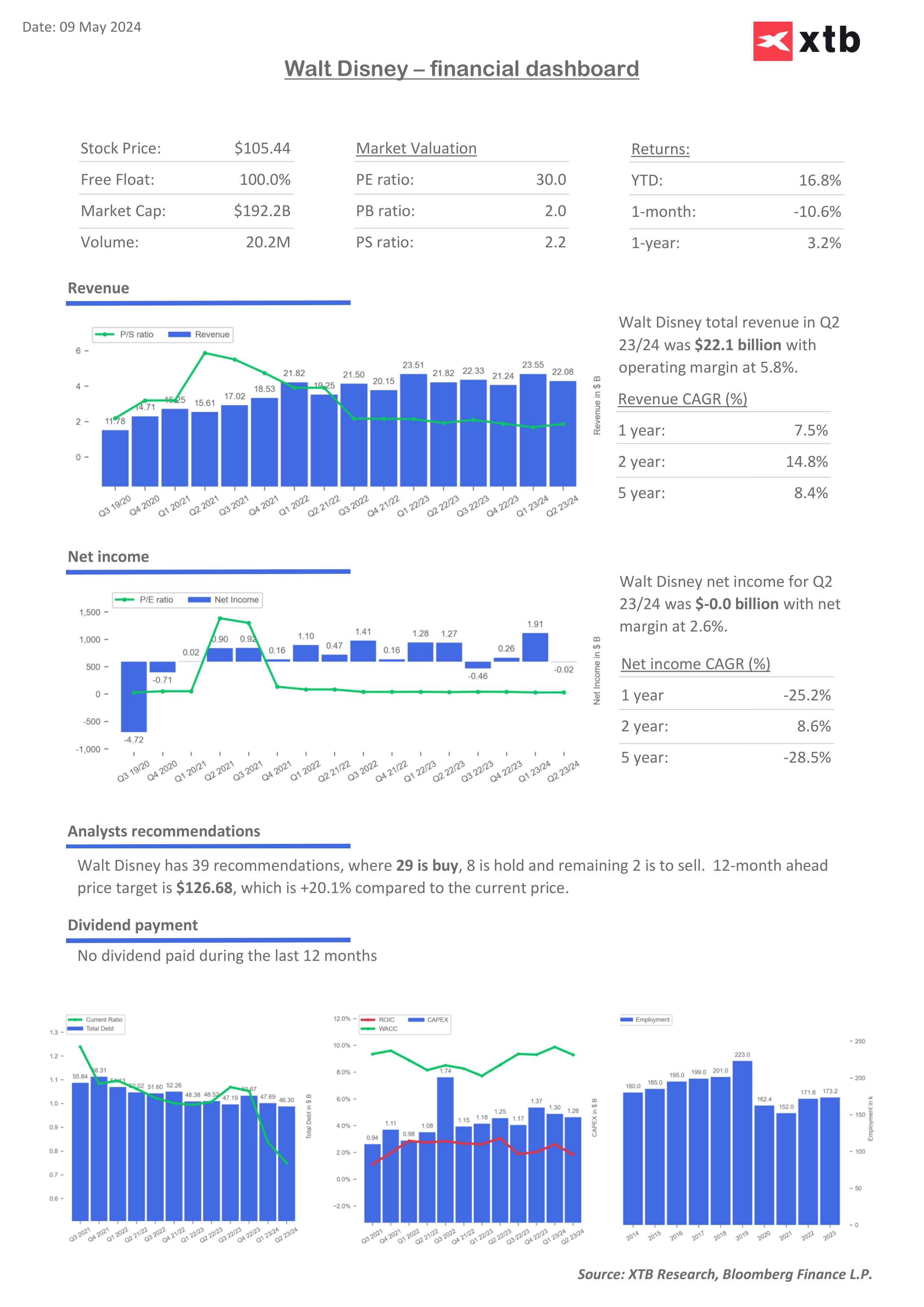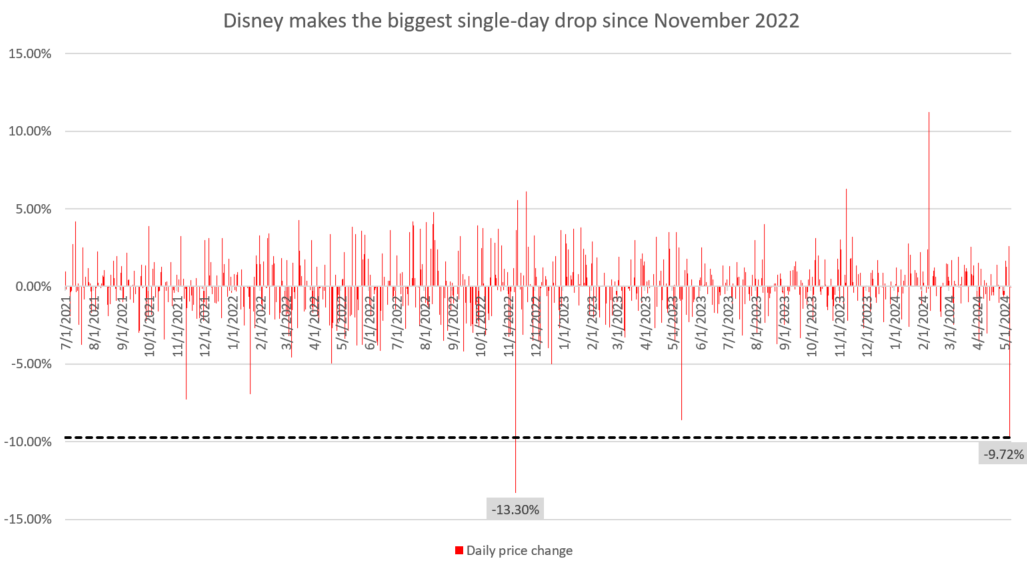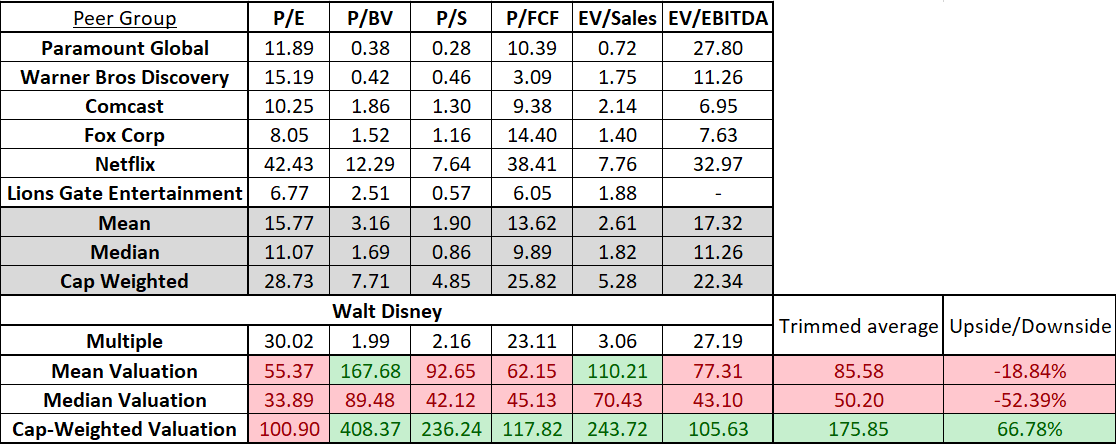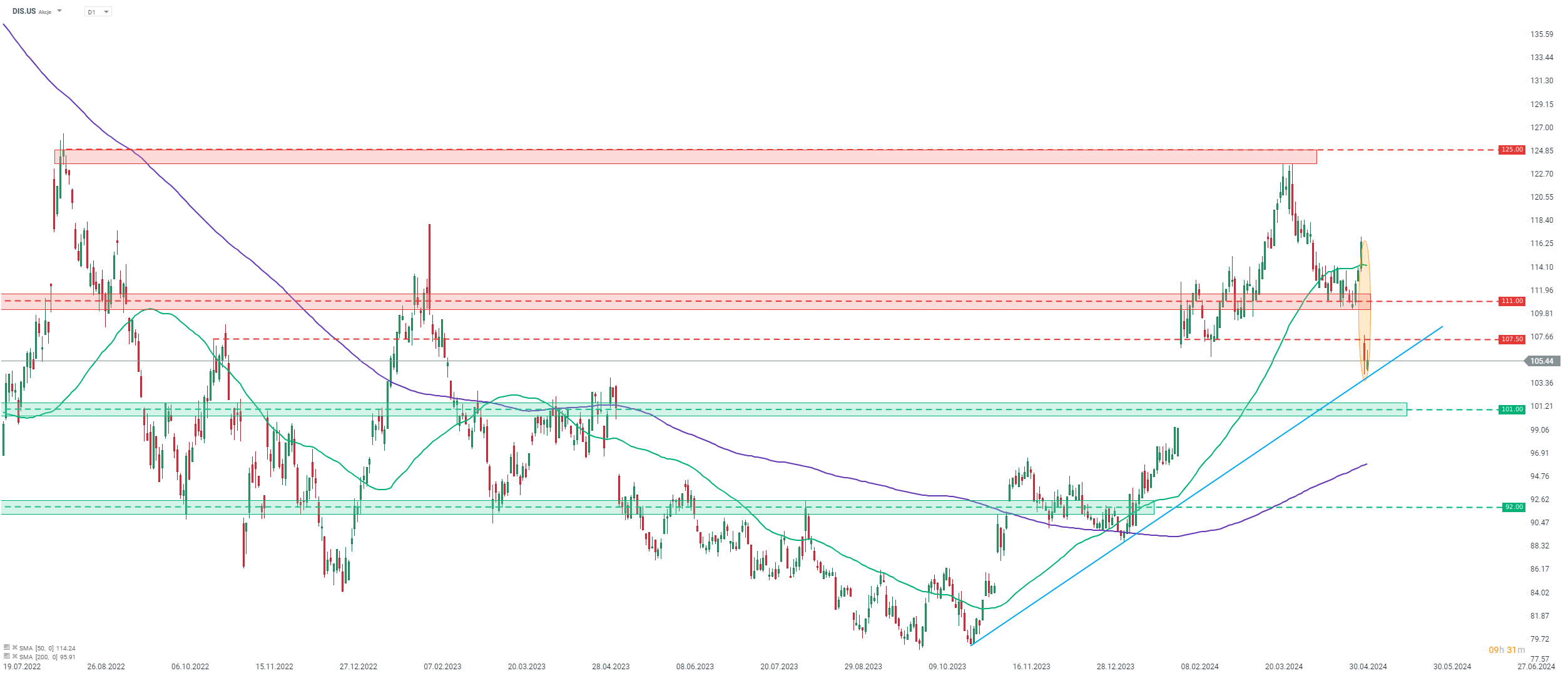- Walt Disney released fiscal-Q2 results this week
- Stock matched sales expectations and beat profit expectations
- New 2024 EPS growth outlook seen as disappointment
- Company expects deterioration in profitability in fiscal-Q3
- Streaming business turns profitable
- A look at valuation
- Stock makes the biggest single-day plunge since November 2022
Walt Disney (DIS.US) plunged on Tuesday this week, responding to release of fiscal-Q2 2024 earnings report (calendar January - March 2024). Stock dropped over 9%, marking the biggest single-day drop since November 2022. Let's take a look whether results and guidance released by the company were in fact that bad to justify such a sharp sell-off!
Fiscal-Q2 2024 earnings disappoint
Walt Disney published its quarterly report for fiscal-Q2 2024 (calendar January - March 2024) on Tuesday this week. Overall, results were rather solid. Company matched revenue estimates as beats in Sports and Experiences divisions offset miss in Entertainment unit. However, profit and margin data turned out to be better-than-expected. A drop in cost of revenue, paved the way for a beat in gross profit as well as improvement in gross margin. Segment operating profit beat expectations, thanks to a solid beat by Sports division. Net income climbed almost 30% compared to a year ago period. Total subscribers number beat expectations but was slightly year-over-year lower, driven by a year-over-year drop in Disney+ subscribers. Nevertheless, fiscal-Q2 2024 was the first quarter in history when Disney's streaming segment turned profit.
Company booked a good will impairment charges of $2.05 billion related to Star India investment during the quarter.
Fiscal-Q2 2024 earnings
- Revenue: $22.08 billion vs $22.1 billion expected (+1.2% YoY)
- Entertainment: $9.80 billion vs $10.31 billion expected (-5.0% YoY)
- Sports: $4.31 billion vs $4.33 billion expected (+2.0% YoY)
- Experiences: $8.39 billion vs $8.18 billion expected (+9.8% YoY)
- Cost of revenue: $14.17 billion vs $14.39 billion expected (-3.0% YoY)
- Gross profit: $7.91 billion vs $7.48 billion expected (+9.9% YoY)
- Gross margin: 35.8% vs 35.1% expected (33% a year ago)
- Segment operating profit: $3.85 billion vs $3.51 billion expected (+17% YoY)
- Entertainment: $781 million vs $808.1 million expected (+71.6% YoY)
- Sports: $778 million vs $733.4 million expected (-2.0% YoY)
- Experiences: $2.29 billion vs $2.27 billion expected (+12.3% YoY)
- Segment operating margin: 17.4% vs 15.9% expected (15.1% a year ago)
- Entertainment: 8.0% vs 7.8% expected (4.4% a year ago)
- Sports: 18.1% vs 16.9% expected (18.8% a year ago)
- Experiences: 27.3% vs 27.7% expected (26.6% a year ago)
- EBITDA: $5.97 billion vs $4.25 billion expected (+29.6% YoY)
- EBITDA margin: 27.0% vs 19.2% expected (21.1% a year ago)
- Adjusted net income: $2.48 billion vs $2.02 billion expected (+29.2% YoY)
- Adjusted net margin: 11.2% vs 9.1% expected (11.4% a year ago)
- Adjusted EPS: $1.21 vs $1.11 expected ($0.93 a year ago)
- Total subscribers: 228.7 million vs 227.6 million expected (-1.1% YoY)
- Disney+ subscribers: 153.6 million vs 155.7 million expected (-2.7% YoY)
- Disney+ Core subscribers: 117.6 million (+12.1% YoY)
- Disney+ Hotstar subscribers: 36.0 million (-32% YoY)
- Hulu subscribers: 50.2 million vs 49.8 million expected (+1% YoY)
- ESPN+ subscribers: 24.8 million vs 26.35 million expected (-2.0% YoY)
- Disney+ subscribers: 153.6 million vs 155.7 million expected (-2.7% YoY)

Financial dashboard for Disney+. Net income data on the dashboard is unadjusted and includes impact of impairment chart. Source: Bloomberg Finance LP, XTB Research
Full-year fiscal-2024 outlook boosted
Walt Disney also updated its fiscal-2024 growth outlook and now expects EPS growth of 25%, up from 20% in the previous guidance. While an outlook boost is welcome, it was not unexpected. In fact, analysts expected an even higher guidance of 25.5%, so guidance offered by the company can be seen as somewhat disappointing. Moreover, Disney said that it does not expect to see a subscriber growth in its core Disney+ streaming business this quarter and that it expects streaming profitability to suffer due to higher expenses. Also, Disney said that it expects little growth at its theme parks business (Experiences) in the current quarter, but that growth should resume later this year.
Fiscal-2024 outlook
- EPS growth: 25% vs 20% in previous guidance (exp. 25.5%)
Stock makes biggest single-day drop since November 2022
Fiscal-Q2 results from Walt Disney were better-than-expected but new fiscal-2024 outlook disappointed. Moreover, company's comments on subscriber growth and profitability in the current quarter have also been disappointing. Having said that one should not be surprised by a post-earnings drop in company's share price. Walt Disney shares dropped 9.7% on Tuesday, reacting to the earnings release. This was the biggest single-day drop the company has experienced since November 2022, when the company plunged over 13% in response to a disappointing fiscal-Q4 2022 earnings report.
 Source: XTB Research
Source: XTB Research
A look at valuation
Let's take a quick look at Walt Disney's valuation with 2 often used valuation methods - DCF and multiples. We want to stress that those valuations are for presentation purposes only and should not be viewed as recommendations or target prices.
As Walt Disney stopped paying dividends in 2019 and made no announcement on resumption of these payouts, the company cannot be valued using Gordon Growth Model, which we often use in our Stock of the Week posts.
Discounted Cash Flow method
Firstly, let's take a look at Walt Disney's valuation with one of the most popular fundamental models - Discounted Cash Flow method (DCF). This model relies on a number of assumptions and we have decided to base those around 5-year averages. Forecasts for 10 years were made with terminal value assumptions being 3% terminal revenue growth and 8.6% weighted average cost of capital (WACC). Running the model with these assumptions leads us to an intrinsic price per Walt Disney share of $182.70 - or over 70% above yesterday's closing price.
A point to note is that the intrinsic value obtained via the DCF method is highly sensitive to assumptions made. Two sensitivity matrices are provided below - one for different sets of Operating Margin and Revenue Growth assumptions and the other for different sets of Terminal WACC and Terminal Revenue Growth assumptions.
 Source: Bloomberg Finance LP, XTB Research
Source: Bloomberg Finance LP, XTB Research
 Source: Bloomberg Finance LP, XTB Research
Source: Bloomberg Finance LP, XTB Research
Multiples
Next, let's take a look at how Walt Disney's valuation compares with peers. We have created a peer group consisting of Paramount Global (PARA.US), Warner Bros Discovery (WBD.US), Comcast (CMCSA.US), FOX Corp (FOXA.US), Netflix (NFLX.US) and Lions Gate Entertainment - Walt Disney's key US competitors in the Film & TV business. We have taken a look at 6 different valuation multiples - P/E, P/BV, P/S, P/FCF, EV/Sales and EV/EBITDA. We have decided to take a look at medians and cap-weighted multiples in calculating valuations.
When it comes to median multiples, Disney's valuations range from $38.89 in case of P/E to $89.48 in case of P/BV. A trimmed average, excluding the highest and the lowest valuation, provides us with an intrinsic value of Walt Disney's shares of $50.19, or over 50% below yesterday's close.
When it comes to cap-weighted multiples, Disney's valuations range from $100.90 in case of P/E to $408.37 in case of P/BV. A trimmed average, excluding the highest and the lowest valuation, provides us with an intrinsic value of Walt Disney's shares of $175.85, or almost 70% above yesterday's close. Such a discrepancy between median and cap-weighted valuations can be blamed on Netflix, which is not only the biggest stock in the peer group, but also trades at the highest multiples.
 Source: Bloomberg Finance LP, XTB Research
Source: Bloomberg Finance LP, XTB Research
A look at the chart
Taking a look at Walt Disney chart at D1 interval, we can see that a sharp post-earnings pushed the stock to the lowest level since early-February 2024, when the stock rallied on the back of better-than-expected fiscal-Q1 2024 earnings release. The drop was halted near the short-term upward trendline in the $105 area. Should the slide resume, the near-term support zone to watch can be found in the $101 area. On the other hand, should bulls regain control, the first two resistance levels to watch are $107.50 and $111.00.

Source: xStation5
US Open: US100 loses 1% amid semiconductors & software stocks sell-off📉
Stock of the week - Comcast Corp (06.11.2025)
Rheinmetall after Earnings: Investors welcome soaring sales and investments
Qualcomm’s Fiscal Q4 2025 Results: Solid Beat Amid Tax Headwinds and Market Caution


